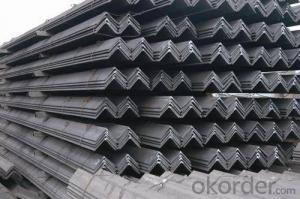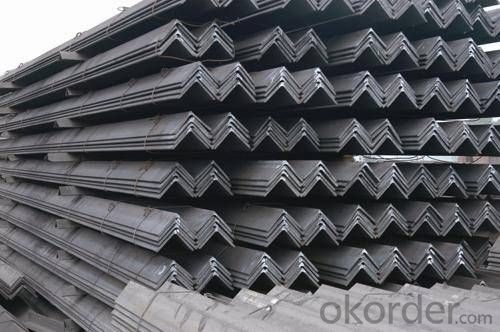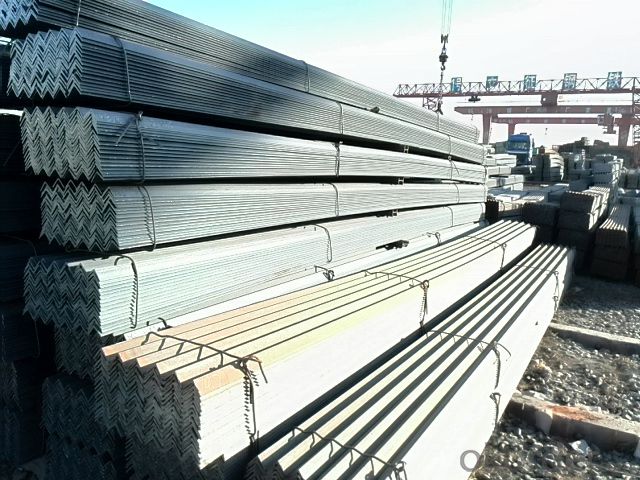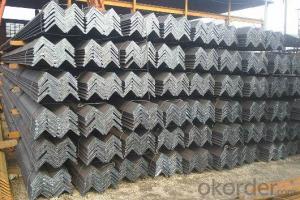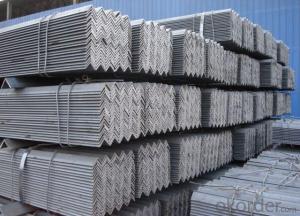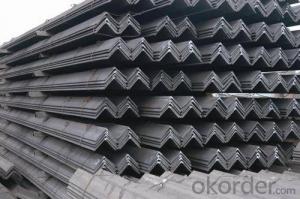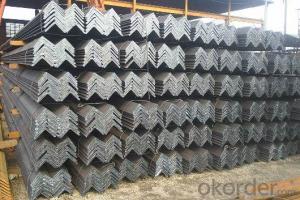Hot Rolled Steel Angle Bars with Lowest Price
- Loading Port:
- Tianjin
- Payment Terms:
- TT OR LC
- Min Order Qty:
- 25 m.t
- Supply Capability:
- 10000 m.t/month
OKorder Service Pledge
OKorder Financial Service
You Might Also Like
Specification
Okorder.com is a professional materials & equipment supplier & manufacturer, offers integrated one-stop services including real-time quoting and online cargo tracking. We are funded by CNBM Group, a Fortune 500 enterprise and the largest materials & equipment firm in China.
Product Applications:
According to the needs of different structures, Angle can compose to different force support component, and also can be the connections between components. It is widely used in various building structures and engineering structures such as roof beams, bridges, transmission towers, hoisting machinery and transport machinery, ships, industrial furnaces, reaction tower, container frame and warehouse etc.
Product Advantages:
OKorder's Steel Angles are durable, strong, and resist corrosion.
Main Product Features:
· Premium quality
· Prompt delivery & seaworthy packing (30-45 days after receiving deposit)
· Corrosion resistance
· Can be recycled and reused
· Mill test certification
· Professional Service
· Competitive pricing
Product Specifications:
1. Invoicing on theoretical weight or actual weight as customer request
2. Length: 6m, 9m, 12m as following table
3. Sizes
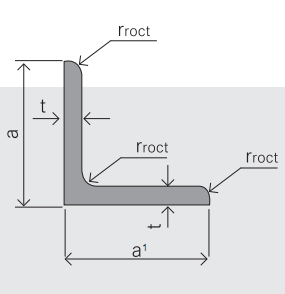
Sizes: 25mm-250mm | ||
a*t | ||
25*2.5-4.0 | 70*6.0-9.0 | 130*9.0-15 |
30*2.5-6.6 | 75*6.0-9.0 | 140*10-14 |
36*3.0-5.0 | 80*5.0-10 | 150*10-20 |
38*2.3-6.0 | 90*7.0-10 | 160*10-16 |
40*3.0-5.0 | 100*6.0-12 | 175*12-15 |
45*4.0-6.0 | 110*8.0-10 | 180*12-18 |
50*4.0-6.0 | 120*6.0-15 | 200*14-25 |
60*4.0-8.0 | 125*8.0-14 | 250*25 |
FAQ:
Q1: Why buy Materials & Equipment from OKorder.com?
A1: All products are carefully selected from China's most reliable manufacturing enterprises. Through its ISO certifications, OKorder.com adheres to the highest standards and a commitment to supply chain safety and customer satisfaction. We can guarantee the quality!
Q2: The products are invoicing on theoretical weight or on actual weight?
A2: We can do it in both manners, it’s according to buyer's requirement.
Q3: Can you offer the third part inspection certificates ?
A3: Yes, we can apply third part inspection before shipping, such as SGS, BV, etc .
Images:
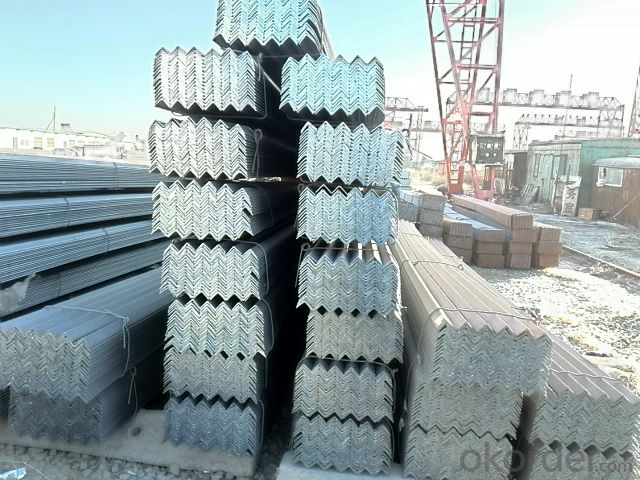
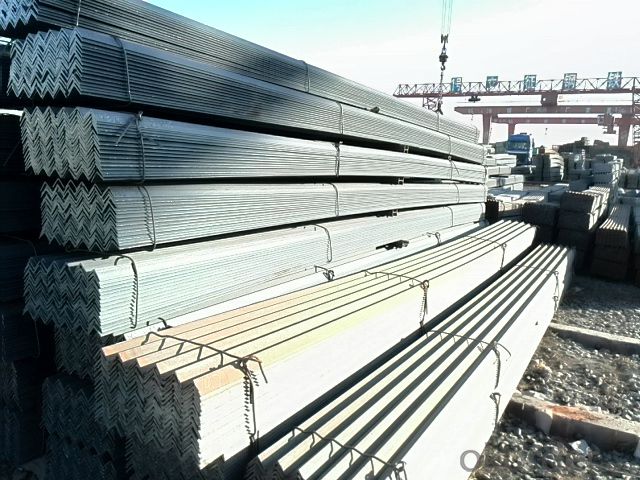
- Q: How are steel angles cut to specific lengths?
- Steel angles can be cut to specific lengths using various tools and methods such as sawing, shearing, or using a plasma cutting machine. These techniques allow for precise and accurate cuts based on the required measurements.
- Q: Can steel angles be used in playground equipment?
- Yes, steel angles can be used in playground equipment. Steel angles are commonly used in the construction industry due to their strength, durability, and versatility. They can be used to provide structural support and stability to various playground equipment such as slides, climbing structures, swings, and playsets. The steel angles can be welded or bolted together to create a sturdy framework that can withstand the weight and movement of children playing. Additionally, steel angles can be coated or painted to provide protection against corrosion and enhance the aesthetic appeal of the playground equipment.
- Q: What are the different surface finishes for steel angles?
- Some of the different surface finishes for steel angles include mill finish, hot-dip galvanized, powder coated, and painted finishes.
- Q: Galvanized steel angles under what conditions?
- Galvanized angle itself coated zinc and iron rust, common need to be coated with a layer of anti rust paint in the construction process, so the galvanized angle in the construction without paint. Suitable for field and outdoor support and Engineering
- Q: What is the typical thickness of a steel angle?
- The specific application and the desired strength are factors that can cause the typical thickness of a steel angle to vary. Generally, steel angles are offered in various thickness options, ranging from 1/8 inch (3.18 mm) to 3/4 inch (19.05 mm) or greater. Determining the appropriate thickness involves considering aspects like load-bearing necessities, structural design, and the desired durability level.
- Q: How do you calculate the second moment of area for a steel angle?
- The second moment of area for a steel angle can be calculated by multiplying the width of the angle squared, multiplied by the thickness cubed, and divided by 12.
- Q: How do steel angles perform in high-temperature environments?
- The inherent properties of steel angles make them highly effective in high-temperature environments. Steel is renowned for its ability to withstand elevated temperatures without significant structural degradation, thanks to its high melting point and thermal conductivity. This means that steel angles maintain their strength and stability, making them suitable for a wide range of applications. A key factor contributing to the exceptional performance of steel angles in high-temperature environments is their structural integrity. Steel has a high melting point, typically between 1300 and 1500 degrees Celsius, depending on the specific grade. This ensures that steel angles retain their shape even in extreme heat conditions, providing durability and reliability. Furthermore, steel's low coefficient of thermal expansion minimizes expansion and contraction when exposed to temperature changes. This is crucial in high-temperature environments as it reduces the risk of warping or distortion of steel angles. The dimensional stability of steel angles enables them to withstand thermal cycling without compromising their structural strength. Moreover, steel exhibits excellent thermal conductivity, enabling efficient heat dissipation. This prevents the accumulation of excessive heat in steel angles, reducing the risk of thermal stress or failure. By effectively transferring heat away from critical components, steel angles increase their durability and longevity in high-temperature environments. Additionally, steel angles can be further enhanced with heat-resistant coatings or treatments. These coatings provide an extra layer of protection against oxidation, corrosion, and thermal degradation, enhancing the resilience of steel angles in extreme heat conditions. To summarize, steel angles are an ideal choice for high-temperature environments due to their high melting point, low thermal expansion, excellent thermal conductivity, and the possibility of additional heat-resistant coatings. Their ability to maintain structural integrity, dimensional stability, and efficient heat dissipation makes them a reliable solution for various applications where exposure to elevated temperatures is a concern.
- Q: Can steel angles be used for support structures in sports arenas or stadiums?
- Sports arenas or stadiums can make use of steel angles for their support structures. The construction industry often opts for steel angles due to their strength, durability, and versatility. These angles are particularly suitable for support structures as they can handle heavy loads and offer stability. In the realm of sports arenas or stadiums, steel angles serve various purposes. They can be utilized to support the roof, create seating platforms, construct staircases, and form the framework for walls and partitions. Architects and engineers can design custom support structures that meet the specific requirements of each sports arena or stadium, thanks to the flexibility of steel angles. Moreover, steel angles can be easily fabricated and joined, which makes them ideal for constructing complex support systems. Their ability to resist bending, twisting, and compression ensures the overall stability and safety of the structure. Additionally, steel is an environmentally friendly material as it is 100% recyclable. By using steel angles for support structures, the construction industry can contribute to reducing carbon emissions and promoting a more sustainable future. In conclusion, steel angles are a dependable and efficient choice for support structures in sports arenas or stadiums. Their strength, durability, versatility, and sustainability make them an excellent option for ensuring the safety and stability of these large-scale structures.
- Q: How do steel angles perform in terms of thermal expansion and contraction?
- Steel angles have a low coefficient of thermal expansion, which means they are relatively resistant to expansion and contraction due to temperature changes. This makes them a reliable choice for structures that require stability and minimal distortion under varying thermal conditions.
- Q: What size does angle iron 125*10 mean?
- The length should be 125mm *125mm and the wall thickness is 10mm
Send your message to us
Hot Rolled Steel Angle Bars with Lowest Price
- Loading Port:
- Tianjin
- Payment Terms:
- TT OR LC
- Min Order Qty:
- 25 m.t
- Supply Capability:
- 10000 m.t/month
OKorder Service Pledge
OKorder Financial Service
Similar products
Hot products
Hot Searches
Related keywords
